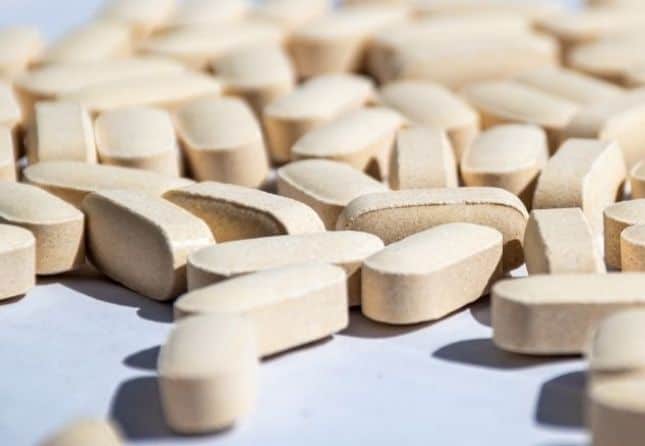Home > Hormones > Hormone health & solutions > How to increase progesterone naturally: Holistic approaches


As women, progesterone plays a key role in our mental and physical health. As a key reproductive hormone, when your progesterone levels are low, you can experience a myriad of symptoms ranging from mild to severe. Depending on the severity of your imbalance, your doctor may prescribe prescription medications, but these can often bring unwanted side effects of their own. If you’re one of the countless women wondering how to increase progesterone levels naturally, the good news is there are holistic methods that can make a huge difference. In this article, we’ll talk about all things progesterone, including how to tell if your levels are low and natural ways to increase this essential hormone.
Progesterone is mainly produced by the ovaries in high amounts after ovulation. This hormone is essential for supporting conception and the development of pregnancy. All that is needed is ovulation to achieve the expected levels of progesterone. It’s as simple as that. Progesterone levels can be lower than usual during the luteal phase in the following situations:
However, sometimes ovulation occurs, but progesterone is not produced in sufficient amounts. This condition is called luteal phase deficiency and may lead to early pregnancy loss.
Having low progesterone during early puberty, when your cycles are just beginning to establish a natural rhythm, and during perimenopause, when they are approaching their final stages, is normal. Similarly, low progesterone levels can be expected when using hormonal contraceptives. If you feel well while on your contraceptive, there is no need to change it just due to low progesterone levels unless you want to become pregnant or are considering other options while navigating through perimenopause.
Finding out you have low progesterone can be disheartening, and it’s common to wonder how to increase progesterone levels safely. Unfortunately, there’s no food or holistic supplement that you can take that contains progesterone since it’s a reproductive hormone your body produces. The good news is that there are numerous ways to increase progesterone naturally.
Women’s bodies produce a number of reproductive hormones, including estrogen, follicle-stimulating hormone, luteinizing hormone, and, you guessed it, progesterone. When your ovaries are ovulating, these hormones are released in a perfect balance. Sometimes, however, your body gets out of whack, and it can impact hormone production. By identifying the underlying issue, you can work to rebalance these essential hormones naturally.
Before we get into how to naturally increase progesterone, we must first discuss the signs and symptoms associated with low progesterone levels. It’s important to note that every woman is different, and you may or may not have all of these symptoms if you have low progesterone. However, these are the most common signs to look out for if you believe you have a hormone imbalance.
While the symptoms of low progesterone can feel overwhelming, knowing how to increase progesterone levels naturally can help you retake control of your body. Remember, ovulation is key! Lifestyle factors such as diet, stress management, and exercise play a crucial role in our hormonal health. By adopting a healthy lifestyle, you can support your body’s recovery and restore ovulation. Take advantage of natural ways to boost progesterone production.
Foods themselves won’t directly increase progesterone production, but they can help your body return to a healthy state, resume ovulation, and thus lead to normal progesterone levels.
Here are a few foods that increase progesterone production indirectly. These foods are rich in essential macro and micronutrients, as well as vitamins. So, what foods increase progesterone? Keep reading to find out!
Protein is essential for hormone synthesis and healthy hormone levels, so it’s important to ensure you add plenty of protein-rich options to your diet. Some great choices include lean meat, fish, avocados, nuts, beans, and seeds. Incorporating these progesterone-boosting foods will help regulate your hormones and keep you feeling great.
Nuts are packed full of magnesium, which can indirectly help control cortisol levels and support hormonal balance and progesterone production. Other foods that contain high levels of magnesium include tofu and dark chocolate.
Spinach has one of the highest concentrations of vitamins A and C, making it one of the best foods to boost progesterone production.
Cantaloupe has 57.3 mg of vitamin C per cup, giving you a healthy dose of this powerful antioxidant. You can also add citrus fruits, cauliflower, green and red peppers, kale, cabbage, and sweet potatoes into your diet to increase your vitamin C intake. A quick note: many of the foods high in progesterone-boosting vitamins may cause bloating, especially as they begin impacting progesterone production. If you experience painful gas, consider switching to options that are easier on your stomach.
All of these vitamins and micronutrients are essential for your body to function optimally and support the return of ovulation.
Learning how to produce more progesterone to balance your hormones starts by giving your body the vitamins it needs to thrive. You can boost your health, restore ovulation, and subsequently naturally increase progesterone using many common over-the-counter vitamins, including:
When seeking how to raise progesterone levels naturally, these supplements can make all the difference.
Blood flow is essential for the proper functioning of the corpus luteum and the production of progesterone. In an experimental study, researchers found that vitamin E could enhance blood supply to the corpus luteum in women with luteal phase deficiency. Therefore, if you’re looking to get more progesterone, consider starting with a daily dose of vitamin E up to 15 mg or 22.4 IU, which is considered safe and is equivalent to 2 ounces of sunflower seeds.
Knowing what increases progesterone can be tricky, but vitamin C is an excellent addition to your supplement regimen. As a natural antioxidant, most people take vitamin C to boost their immune system, but did you know it also helps support luteal hormone production? Maintaining healthy vitamin C levels is believed to aid ovarian function, boosting progesterone synthesis in women with low progesterone levels.
One more tip for how to get more progesterone naturally is to consume a healthy amount of sodium. Although it’s hard to imagine that it’s possible to have a low sodium intake these days, when it is quite difficult to control and avoid overconsumption, sometimes it does happen. Researchers have noticed that when women consume less than 1500 mg of sodium per day in their meals, it leads to lower progesterone levels. So, as usual, balance is key!
Did you know there’s one thing that can negatively impact your body and hinder its ability to function properly: persistent stress? That’s right, persistent stress is your body’s worst enemy, impacting you from your head to your toes. When looking at how to increase progesterone naturally, magnesium may seem like a weird addition, but if you look a little more closely, it’s easy to see why this supplement tops our list. Magnesium effectively calms the nervous system and stops the production of the stress hormone cortisol. When your stress hormones are in balance, it makes it easier for your body to balance its reproductive hormones, including progesterone.
Your doctor may prescribe progesterone medication to support your menstrual cycle if you previously had periods that have since stopped, a condition known as secondary amenorrhea. Additionally, it may be prescribed to protect your uterus from the effects of estrogen if you are taking estrogen medications as part of hormone replacement therapy during perimenopause.
For most women, the benefits of taking this medication outweigh any potential risks, and the likelihood of experiencing adverse effects is generally low. However, there are situations where the dosage may need to be increased or the duration of treatment extended, which can elevate the associated risks. Therefore, if you are breastfeeding, have a history of breast cancer or stroke, suffer from severe allergies, or are taking other medications, it is crucial to share this information with your doctor before starting progesterone.
While your body needs progesterone to function properly, taking too much can cause adverse reactions. When seeking how to fix low progesterone, it’s important to talk with your doctor to ensure you raise your levels safely.
When choosing to treat low progesterone naturally, these tips can make the process easier and more effective.
Healthy eating will ensure the proper functioning of your body, aid ovulation, and thus promote optimal progesterone production.
Stress releases cortisol, which can cause hormonal disruptions. Stress management techniques like meditating, journaling, and exercising can be a huge help.
Sleep is essential for your body to function properly, so making sure you strive for 7 to 9 hours per night can support your hormone regulation.
Excess weight puts a strain on your body and can impact your hormone production. Maintaining a healthy weight gives your organs a boost and makes it easier to function properly.
Low progesterone can cause numerous symptoms like irregular menstrual cycles and fertility problems. Learning how to increase your progesterone levels naturally can help you avoid medications and feel your best. Tracking your hormones allows you to monitor your hormonal health and make sure your body is functioning the way it should. The Hormona app makes it easy to track your hormones anytime, anywhere. This award-winning app provides comprehensive insights and tools to help you understand your body and feel your best.

-


Dr Singh is the Medical Director of the Indiana Sleep Center. His research and clinical practice focuses on the myriad of sleep.

Understanding perimenopause and its symptoms When it comes to aging, many women know about menopause but are surprised to learn about the transitional stage leading up to it, called perimenopause. There are three stages of perimenopause: early, late, and menopause,

Sugar cravings are something many people experience, and they can pop up for a few different reasons. One of the most common reasons is simply habit – if you regularly eat sugary foods, your body starts to expect them. Another

The basics of progesterone – What is it? In the menstrual cycle, the two most important sex hormones are estrogen and progesterone. But what is progesterone hormone and what does it do? Progesterone is a steroid hormone. So, what is
| Cookie | Duration | Description |
|---|---|---|
| cookielawinfo-checkbox-analytics | 11 months | This cookie is set by GDPR Cookie Consent plugin. The cookie is used to store the user consent for the cookies in the category "Analytics". |
| cookielawinfo-checkbox-functional | 11 months | The cookie is set by GDPR cookie consent to record the user consent for the cookies in the category "Functional". |
| cookielawinfo-checkbox-necessary | 11 months | This cookie is set by GDPR Cookie Consent plugin. The cookies is used to store the user consent for the cookies in the category "Necessary". |
| cookielawinfo-checkbox-others | 11 months | This cookie is set by GDPR Cookie Consent plugin. The cookie is used to store the user consent for the cookies in the category "Other. |
| cookielawinfo-checkbox-performance | 11 months | This cookie is set by GDPR Cookie Consent plugin. The cookie is used to store the user consent for the cookies in the category "Performance". |
| viewed_cookie_policy | 11 months | The cookie is set by the GDPR Cookie Consent plugin and is used to store whether or not user has consented to the use of cookies. It does not store any personal data. |
